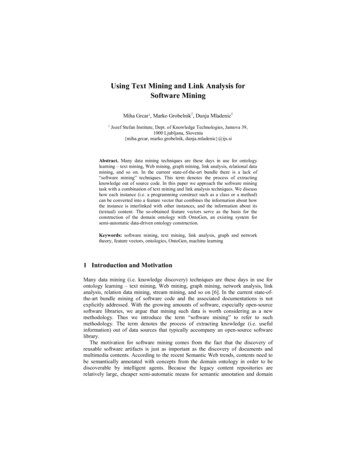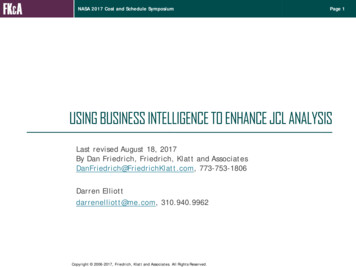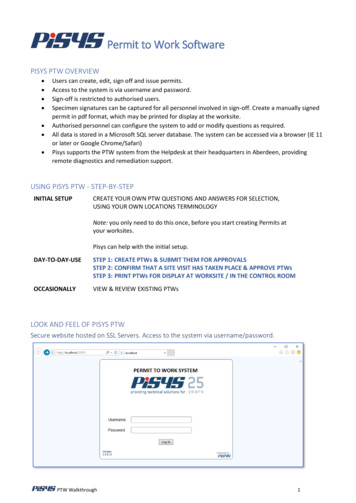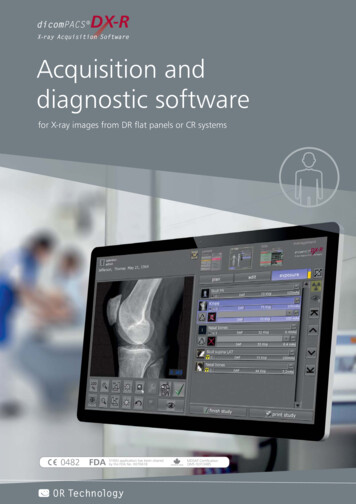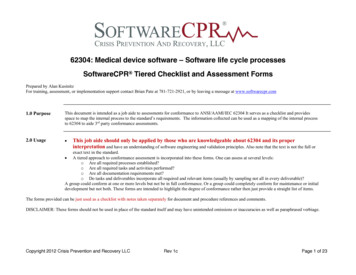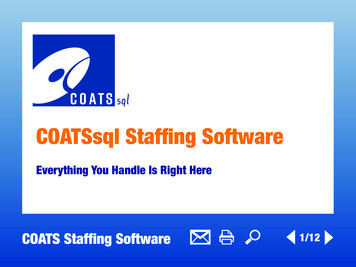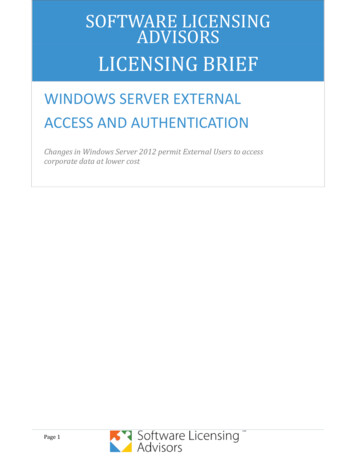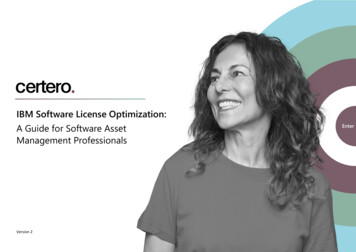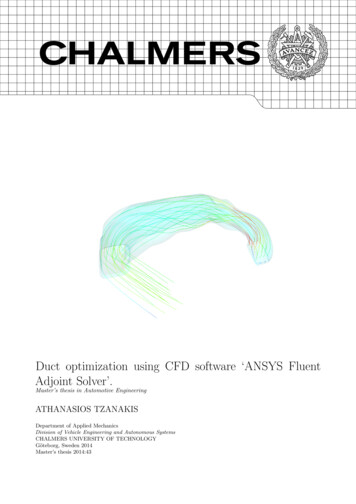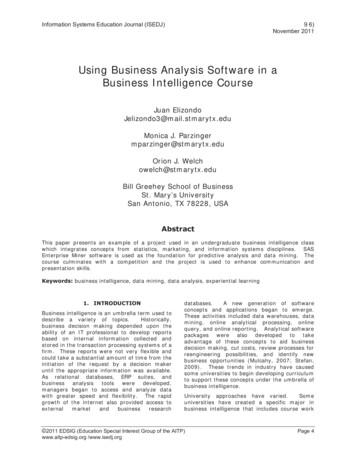
Transcription
Information Systems Education Journal (ISEDJ)9 6)November 2011Using Business Analysis Software in aBusiness Intelligence CourseJuan ElizondoJelizondo3@mail.stmarytx.eduMonica J. Parzingermparzinger@stmarytx.eduOrion J. Welchowelch@stmarytx.eduBill Greehey School of BusinessSt. Mary’s UniversitySan Antonio, TX 78228, USAAbstractThis paper presents an example of a project used in an undergraduate business intelligence classwhich integrates concepts from statistics, marketing, and information systems disciplines. SASEnterprise Miner software is used as the foundation for predictive analysis and data mining. Thecourse culminates with a competition and the project is used to enhance communication andpresentation skills.Keywords: business intelligence, data mining, data analysis, experiential learning1. INTRODUCTIONBusiness intelligence is an umbrella term used todescribe a variety of topics.Historically,business decision making depended upon theability of an IT professional to develop reportsbased on internal information collected andstored in the transaction processing systems of afirm. These reports were not very flexible andcould take a substantial amount of time from theinitiation of the request by a decision makeruntil the appropriate information was available.As relational databases, ERP suites, andbusinessanalysistoolsweredeveloped,managers began to access and analyze datawith greater speed and flexibility. The rapidgrowth of the internet also provided access toexternalmarketandbusinessresearchdatabases.A new generation of softwareconcepts and applications began to emerge.These activities included data warehouses, datamining, online analytical processing, onlinequery, and online reporting. Analytical softwarepackages were also developed to takeadvantage of these concepts to aid businessdecision making, cut costs, review processes forreengineering possibilities, and identify newbusiness opportunities (Mulcahy, 2007; Stefan,2009). These trends in industry have causedsome universities to begin developing curriculumto support these concepts under the umbrella ofbusiness intelligence.University approaches have varied.Someuniversities have created a specific major inbusiness intelligence that includes course work 2011 EDSIG (Education Special Interest Group of the AITP)www.aitp-edsig.org /www.isedj.orgPage 4
Information Systems Education Journal (ISEDJ)in ERP suites, data warehouses, data mining,and dimensional analysis. Other programs havedefined the term more narrowly to the analyticaltools associated with improving decision making.In either case, one of the problems facingcurriculum design for business intelligence is theselection of analysis software to be used in theclasses and the design of instructional projectsthat can effectively demonstrate the concepts.This paper describes one approach that wassuccessful in an introductory level businessintelligence class using SAS Enterprise Miner asa data modeling tool for predictive analysis.The instructional techniques and the projectpresented and described in this paper might beuseful for designing a course using businessintelligence analytical software packages.2. BUSINESS INTELLIGENCE IMPACTIndustry is embracing recent trends in BusinessIntelligence applications and recognizing thebenefits for adopting an integrated businessintelligence strategy.Chickowski (2009)identified five important trends, one of thembeing predictive analytics. The other four areagiledevelopment,customizationofBIinformation, visualization improvements, andoperationalization of BI systems or the ability foroperational level managers to see the predictiveresults of operational decisions in real time. Inaddition, Software as a Service (SaaS) and cloudcomputing are technological trends which enablefirms to develop and deploy BI initiatives moreefficiently (Henschen, 2009; Thompson 2009).A survey conducted by CIO Insight identifiedbusiness intelligence/data mining as thetechnology most likely to make significantcontributions to business strategy (Sircar,2009).The convergence of technology and applicationsthat has occurred since 2000 has made businessprocesses and data analysis a key differentiatorfor competitive advantage (Brannon, 2010).Integration provides even more advantages andopportunities.Benefits of adopting anintegrated BI strategyinclude cost savingsrelated to consolidation of data marts, timesavings for data suppliers and users, higherquality data leading to better decisions, andimproved business processes (Popovie, Turk &Jaklic, 2010; Watson & Wixsom, 2007). Thetypes of data stored for analysis has alsoexpanded.Baars and Kemper (2010) havestressed the importance of integrating both9 6)November 2011structured and unstructured content within theBI zational benefits, there is a disconnectbetween industry needs and business schoolcurriculum (Sircar, 2009). Sircar examined BIcourse offerings in the top 50 undergraduatebusiness schools as ranked in Business Weekand found that only 7 schools had specificcourses in BI or Business Analysis. None of theschools offered a major in BI, and only one,Miami University of Ohio, offered a minor.Analytical competency and insufficient employeequantitative skills were found to be seriousconcerns of business executives yet universitieshave been slow to adopt BI into their curriculum(Sircar, 2009).3. BI COURSE DESCRIPTIONIn order to address the shortcomings of thebusiness school curriculum in regards toBusiness Intelligence, a new course wasintroduced at both the undergraduate andgraduate level.The catalog provides thefollowing course description and is a requiredcourse for all undergraduate InformationSystems Management majors:Developmentand application of the strategies, methods, andtechniques used in data mining and otherdecision support systems. The course employstesting, documenting, and using softwareprograms in functional areas of business such asfinance, production, marketing, and accounting.The use of SAS software is employed for handson data mining experience.Students arerequired to have completed a business statisticscourse prior to enrollment in the BI course.SAS software was chosen for multiple reasons.SAS has been a leader in business analyticssoftware and is used by several of the potentialemployers of our student body. SAS also offersa certification in predictive analytics. Studentsare encouraged to consider certification forimprovingtheirpersonaljobsearchopportunities. SAS also offers access to theirbusiness analysis software through the cloud.This carried a tremendous advantage for ouruniversity since we do not have computer labs.Students are required to have a laptop,therefore, it was very easy to approach thiscourse using software as a service. SAS alsoprovides free training to university instructorsand extensive course material which can be usedin the classroom, alleviating the necessity topurchase costly textbooks. SAS also provides 2011 EDSIG (Education Special Interest Group of the AITP)www.aitp-edsig.org /www.isedj.orgPage 5
Information Systems Education Journal (ISEDJ)online support and quick response to userproblems that can and will be encountered. Lastbut far from least, SAS was chosen for itspolicies toward its employees. SAS has been onFortune's list of Best Companies to Work for thepast 13 years, as long as the rankings havebeen published.In January 2010, SAS wasnamed as the number one best 9 6)November 2011Table 1 below provides the list of topics coveredin the undergraduate Business Intelligence class.Theproject provided thestudents theopportunity to integrate coursework and add totheir portfolio of experiential learning activities.Table 1 Topics CoveredProblemFormulationIRB Certificationy/sas best companies.fortune/).The course content closely follows the Trainer’sKit provided by SAS when the softwareagreement with the university was finalized.Because the university requires undergraduatestudents to have a laptop computer, thesoftware was accessed as a cloud application.This environment is termed OnDemand forAcademics by SAS.Regression analysis,decision trees, and neural networks are thethree modeling tools upon which the coursefocuses.Students learn to build all threemodels and use tools to compare and identifythe model with the best fit for the situation.SAS provides datasets which spotlight businessdecisions.4. CLASS CHARACTERISTICSBusiness Intelligence is a required, senior levelclass for all undergraduate IT majors under anewly implemented IT curriculum in the BillGreehey School of Business. It is also availableto any business major as an elective predicatedupon completion of a basic statistics course.Seven students enrolled in the initial offering ofthe undergraduate course and participated in theproject described below. The students wereprimarily IT majors although two of those werepursuing a double major, one in accounting, theother in marketing. Two other students weregeneral business majors and a sole marketingmajor had enrolled.Students had varyingviewpoints and skills when beginning the coursewhich supported the interdisciplinary approach.While the course is currently taught byInformation Technology faculty, it is possible forthe course to be conducted within the domain ofother business disciplines.Marketing, inparticular, could benefit from the offering ofsuch a course due not only to the survey aspectsaddressed but also the type of data SAS hasincorporated into their examples and trainingmaterials. The statistical aspects of the coursesupport upper level Finance decisions and SAShas included training data to assist students indecision-making in this field, too.Informed ConsentFormsSurveyDevelopmentData CollectionData EntryData IntegrityGraphs/ChartsNeural NetworksCollaborationSoftwareCloud ComputingTeamwork5. THE PROJECTProblem IdentificationStudents were asked to explore opportunities inand around the campus for a research projectthat could help management in a decisionmaking situation. After some brainstorming, thegroup chose a project that could aid on-campusbookstore sales.Students noted that onlinetextbook purchasing had become easier andeconomically feasible. Thus students may bemore apt to buy online rather than spendingmoney at the bookstore. The goal of the projectwas to develop a predictive model for bookstoretextbook purchases. By recognizing importantvariables, bookstore management could takeaction to manipulate those variables or offerenticements to individuals identified as mostlikely to buy online.IRB CertificationWhile determining the problem to be researched,students became certified by the IRB (InternalReview Board) to perform human subjectresearch. They also began preparation of theIRB application. Google Docs was one of the ITtools used extensively throughout the project.This collaboration tool was used not only for theIRB application, but also in the informed consentform, the survey development process, and laterin data entry. Even when all of the studentswere located in the same room, they often 2011 EDSIG (Education Special Interest Group of the AITP)www.aitp-edsig.org tisticsRegressionAnalysisDecision TreesPage 6
Information Systems Education Journal (ISEDJ)worked individually without discussion on theone copy of the document.Survey DevelopmentThe items used on the survey were developedprimarily through student discussion rather thanliterature review. Students speculated causesand characteristics which might influencetextbook purchases on campus and those thatcould impact online purchases. The survey wascomprised of 10 questions which studentsbelieved were independent of each other. It wasdecided that the target participation group wouldbe students in the business and law schools dueto easy accessibility and time constraints. Theappendix includes the questions included in thesurvey.Data CollectionAll students were assigned to the process ofdata gathering by approaching target grouprepresentatives in a random manner.Theinstructor also distributed the survey in businessclasses. Each potential participant was verballyasked to assist in the class project but was alsoinformed of his or her right to refuse withoutpenalty. A total of 76 responses were used inthe analysis.Study participants were comprised of bothbusiness and law school students currentlyenrolled within the University. Participants wereselected based on the courses in which theywere enrolled and accessibility to individuals.Faculty were asked to assist with the distributionduring class periods. The research project wasdepicted to participants as a study focusing onthe purchasing patterns of individuals whopurchase textbooks online or at the St. Mary’sbookstore.Involvement in the study wasvoluntary and anonymous. A numeric code wasutilized to manipulate and aggregate the data.Research participants were not compensated fortheir participation in this study.Data AnalysisThe foundation of this course is explored in thedata analysis stage.Students used SASEnterprise Miner to develop models that predictwhich business and/or law students are mostlikely to purchase their textbooks in the campusbookstore. Figure 1 in the Appendix is a pictureof the SAS models and the nodes used in thecomparison.Presentation of ResultsStudentspreparedapresentationusingMicrosoft PowerPoint to summarize results. Thiswas used in the Computer Sciences’ department9 6)November 2011ITSymposium.AreaITprofessionalsparticipated in the symposium as reviewers andjudges. This added the opportunity to displayour students’ IT and communication skills as wellas additional exposure to the school’s ITcurriculum. The students were awarded cordsthat can be worn during their graduationceremony.Descriptive statistics of the participants werepresented.For example, the distribution ofrespondents living on campus and off campus isdisplayed in Figure 2 below.Figure 2 Participant’s Residency45Off-CampusOn-CampusThe results of the decision tree were presented.As can be seen from the diagram in Figure 3below, the only significant factor was found tobe whether or not the student had a chargeaccount at the bookstore.Figure 3. Decision TreeVarious methods of regression were applied.Results of stepwise as well as forward regressionanalysis are shown in Figure 4 below. Bothresulted in the imputed variable Charge to bethe only significant factor determining if thestudent would likely buy online or at thebookstore. In addition, the neural network wastrained immediately with the dataset entered. 2011 EDSIG (Education Special Interest Group of the AITP)www.aitp-edsig.org /www.isedj.org31Page 7
Information Systems Education Journal (ISEDJ)Figure 4.ExamplesRegression and NNResults Stepwise Modeltrained in Step 1 Imp Charge9 6)November 2011also aid the study in analyzing key elementsinfluencing an individual's purchasing habitswhen it comes to purchasing course textbookswithin a physical store or online. The researchfindings were expected to identify key predictorsin an individual's behavior and also illustrate ntechnologyapplicationstomanipulate data into relevant information Forward6. BI COURSE BENEFITS Modeltrained in Step 1 Imp Charge NN 0IterationsThe Average Squared Error was used as the fitstatistic to choose the appropriate model. Ascan be seen from the results in Table 2, thedecision tree and regression equation producedsimilar model fits.Table 2 ResultsModelASE 6630NN.51121835The benefits of this study include enhancingtheoretical concepts within the dynamic field ofbusiness intelligence and data mining. Using theSAS Enterprise Miner 5.3 statistical package willWhile empirical data depicting the learningoutcomes was not obtained for this course,anecdotal evidence suggests that the contenthelps bridge the gap between the use ofbusiness intelligence software in the corporateenvironment and the neglect of this topic inbusiness school curricula. The project approachhelps students integrate the importance of dataintegrity and statistical analysis for decisionmaking in multiple arenas. The software exposesundergraduates to techniques such as decisiontrees and neural networks which are available inthe business world to assist in problem-solving.The use of the software itself is simply asecondary benefit derived from the course. Wehope that other faculty members can benefitfrom our approach to expanding studentknowledge in the field of Business Intelligence.7. REFERENCESBaars, H. & Kemper, H. (2008) Managementsupport with structured and unstructureddata – an integrated Business Intelligenceframework. Information SystemsManagement 25(2), 132-148.Brannon, N. (2010). Business Intelligence and ediscovery. Intellectual Property &Technology Law Journal 22(7), 1-5.Chickowski, E. (2009). Five trends changing theface of BI. Smarter Technology September,18-21.Henschen D. (2009) 4 technologies that arereshaping Business Intelligence. IntelligentEnterprise 12(8), 1-1.Mulcahy, R. (2007) Business Intelligencedefinition and solutions, CIO.com, March 6,1-4.Popovic, A., Tomaz, T. & Jaklic, J. (2010)Conceptual model of business value of 2011 EDSIG (Education Special Interest Group of the AITP)www.aitp-edsig.org /www.isedj.orgPage 8
Information Systems Education Journal (ISEDJ)Business Intelligence systems. Management:Journal of Contemporary ManagementIssues 15(1), 5-30.Sircar, S. (2009). Business Intelligence in thebusiness curriculum. Communications of the9 6)November 2011Association for Information Systems 24(17),289-302.Watson, H. & Wixom, B. (2010) The currentstate of business intelligence. Computer,September, 96-97.APPENDIXFigure 1. Example SAS Model 2011 EDSIG (Education Special Interest Group of the AITP)www.aitp-edsig.org /www.isedj.orgPage 9
Information Systems Education Journal (ISEDJ)9 6)November 2011Business Intelligence Book Purchasing Survey1.Gender? (Please Circle One)MaleFemale2.Where is your place of residence during the school semester? (Please Circle One)on-campus / off-campus3.What is your academic classification?Undergraduate: (Please Circle One) Fr. Soph. Jr.OR(Please Circle One) Graduate Law Student4.Sr.Do you purchase textbooks in the St. Mary's bookstore? ( Yes / No )If no, do you purchase textbooks online, in another bookstore or from another student?Indicate here:5.Do you engage in online banking? ( Yes / No )6.How comfortable are you purchasing course-related textbooks online? (Circle One)A.B.C.D.E.Extremely UncomfortableSlightly UncomfortableUncomfortableComfortableExtremely Uncomfortable7.Do you currently use the school's bookstore charge account? (Yes / No)(Circle no if you don't have access to one)8.Which factor deters you the most from purchasing books in the St. Mary's bookstore? (Circle One)A. Cost of new/used textbooksB. Selection of used booksC. Selection of new booksD. Other(If other please specify):9.What is your current status of employment? (Circle One)A. UnemployedB. Part-timeC. Full-timeD. Paid/non-paid internship10.Do you currently receive financial assistance (scholarships, grants,loans, etc.)?( Yes / No )If yes, do you use it towards the purchase of textbooks? ( Yes / No ) 2011 EDSIG (Education Special Interest Group of the AITP)www.aitp-edsig.org /www.isedj.orgPage 10
textbook purchases. By recognizing important variables, bookstore management could take action to manipulate those variables or offer enticements to individuals identified as most likely to buy online. IRB Certification While determining the problem to be r
